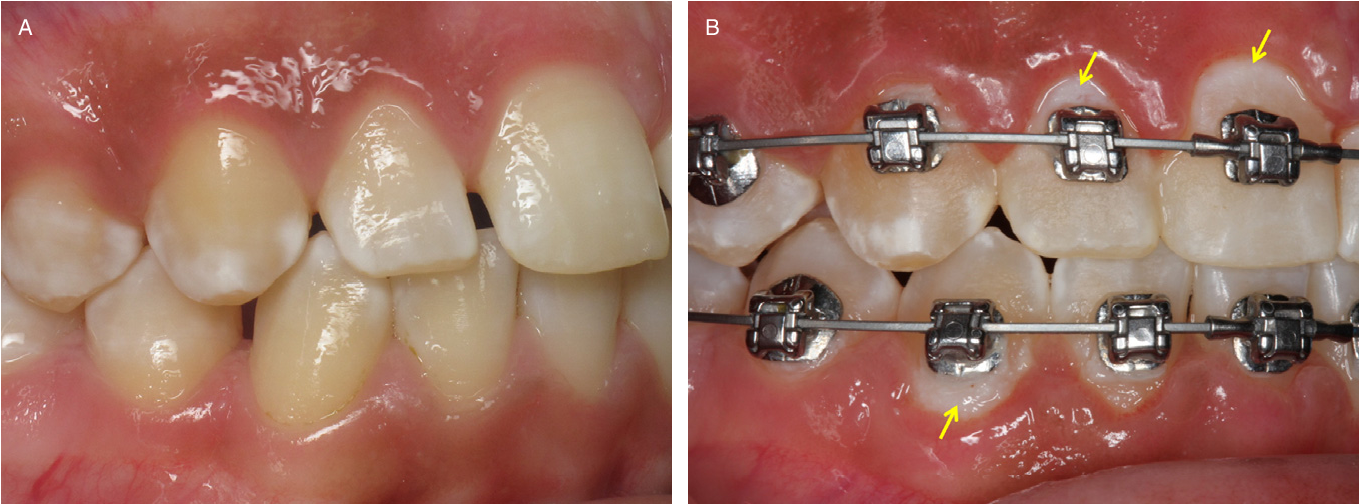Fixing white spots on teeth after orthodontics
On average 1 in 2 orthodontic patients develop white spot lesions (WSL) over the course of their orthodontic treatment 1. Good oral care and patient management obviously help reduce the incidence, however cases of restricted access and reduced salivary flow from traditional wire braces and newer clear aligners can make white spots inevitable in many patients.
Traditional treatments to help prevent lesions developing have included the use of high concentration fluoride treatments and remineralising agents such as ACP CPP. Now, Bioactive
glasses can control the delivery of calcium, phosphate and fluoride for extended periods (after brushing) and are changing the landscape with improved performance, compliance, cost and low risk allergen profiles.

High concentration fluoride becoming less popular
The use of high concentration fluoride is coming under increased criticism from a larger section of the community. This criticism stems not only from the anti‐fluoride campaigners, but also from a growing educated cohort who question the risk/ benefit relationship.
A recent Cochrane clinical review2 by Walsh T et al did reconfirm the benefit of using fluoride in the prevention of caries but did also comment that the “Evidence for the effects of different fluoride concentrations is more limited”
BioMin an alternative to ACP CPP – More cost effective, without the extra step and no milk proteins
Remineralising agents containing Casein phosphopeptide–amorphous calcium phosphate (ACP‐CPP) have become the norm in many practices to help reduce white spot lesions developing and to treat / repair white spots post treatment. The provision of bioavailable calcium and phosphate helps drive the rate of remineralisation delivering significantly higher remineralisation rates than fluoride alone3
New products have come to market in recent times as an alternate to ACP‐CPP, these products include bioactive glasses (calcium fluoro phosphosilicate) that also contain bioavailable calcium and phosphate and fluoride in ionic form. Sold under the trade name BioMin F, this biomimetic approach delivers several advantages. As a dentifrice / toothpaste BioMin F becomes a one step process as it becomes the patient’s everyday toothpaste, it also benefits from being around 40% cheaper per tube for the patient 4.
Ongoing fluoride availability
BioMin F’s patented technology includes fluoride within the bioactive glass structure to provide continuous development of acid resistant fluorapatite on the tooth. With brushing BioMin coats the tooth’s surface, the coating dissolving over time and extending the duration the fluoride is made available. In contrast traditional soluble fluoride dentifrices can suffer from rapid fluoride decline as salivary flow eliminates the fluoride from the oral cavity (therapeutic availability approx. 1450 ppm, approx. 90 mins) 5.
Fluoride used more efficiently means less is needed
BioMin F is congruent with the recommendations from the world renowned cariologist, Prof ten Cate: 6 “For treatments to be effective longer than the brushing and salivary clearance, fluoride needs to be deposited and slowly released”. The ability to control the release of fluoride also means that BioMin F can use fluoride more efficiently. Containing only 530 ppm when packed, BioMin F has the same fluoride concentration as most child (3 years) toothpastes.
The low concentration slowly released fluoride does not appear to inhibit but actually promotes performance of the product, as it was shown to have far superior remineralisation rates when compared with 9,000 ppm fluoride gel 7. The low fluoride content enabled penetration of calcium and phosphate through the porous enamel sub‐surface, causing the re‐mineralisation of the subsurface enamel lesion rather than the outer enamel surface. BioMin F is becoming a widely appreciated by Orthodontists to reduce the risk of WSL. Patients are benefiting from the protective and reparative benefits that help prepare enamel prior to treatment and help inhibit white spot development.
References
- Talic, Nabeel F. “Adverse Effects of Orthodontic Treatment: A Clinical Perspective.” The Saudi Dental Journal 23.2 (2011): 55–59.
- Walsh T, Worthington HV, Glenny AM, Marinho VCC, Jeroncic A. Fluoride toothpastes of different concentrations for preventing dental caries. Cochrane Database of Systematic Reviews 2019, Issue 3. Art. No.: CD007868. DOI:
10.1002/14651858.CD007868.pub3. - Effect of added calcium phosphate on enamel remineralisation by fluoride in a randomised controlled In situ trial
PeiyanShen, Morton et al, Journal of Dentistry 2011, 518 - BioMin F RRP Australia $12.50. GC Tooth Mousse Plus eBay price range $21 per tube. 13.01.20
- Gillam Et al Dentine Hypersensitivity advances in Diagnosis Management and Treatment.
- Eur J Oral Sci. 1997 Oct;105(5 Pt 2):461‐5.
- Bakry AS, et al, A Novel Fluoride Containing Bioactive Glass Paste is Capable of Re‐Mineralizing Early Caries Lesions.
Materials. 2018; 11(9):1636.
